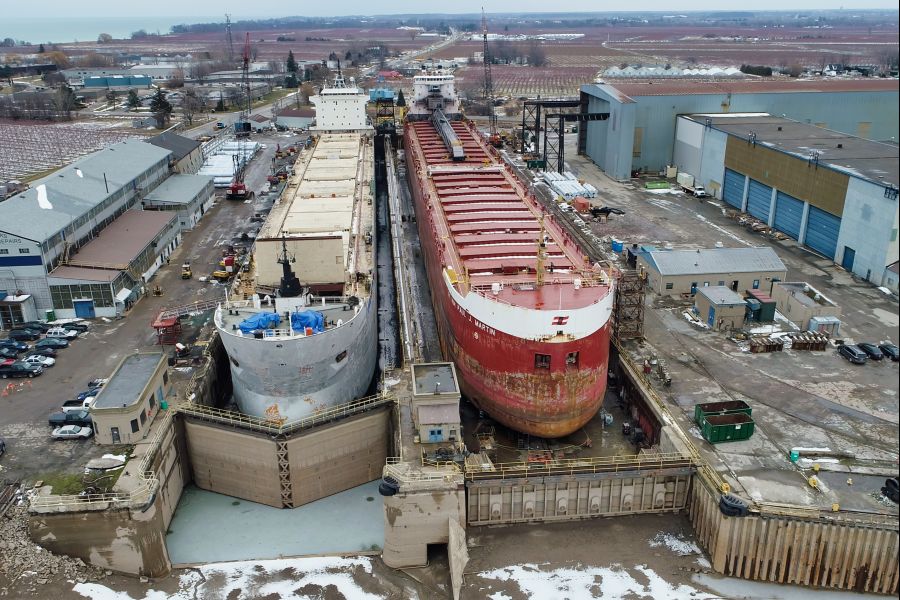There’s a sense of urgency at Heddle Shipyards’ graving docks at Port Weller. An urgency that has rarely been matched in the Niagara drydock’s recent history.
For the first time in decades, the drydock is undertaking extensive maintenance work on two large bulk carriers, at the same time. The work must be completed by the reopening of the Welland Canal, expected in late March.
The short Great Lakes shipping season simply demands its ships be operational for every ice-free moment.
When the Rt. Hon. Paul J. Martin arrived late last December and the Kaministiqua a few days later, the Heddle Shipyards team sprang into action, dedicating 150 skilled trades and labourers to the mammoth task.
According to Ted Kirkpatrick, business development manager for Heddle, the 2020 crew works two shifts a day, only idle for four hours. “This is the busiest we’ve ever been here,” says Kirkpatrick.
In 2017, Heddle entered into a long-term lease with the St. Lawrence Seaway Management Corporation, which manages and operates the Canadian assets of the Seaway on behalf of the government of Canada.
Over the past few decades, the Port Weller drydock has been empty more than it has been full — a checkered history of excitement and disappointment driven by the fortunes of the Great Lakes marine industry.
But you wouldn’t know that today.
Heddle Shipyards owns and operates drydocks for vessel repairs, maintenance and overhauls in Port Weller, Hamilton (where it is headquartered), Thunder Bay, Newfoundland and Nova Scotia.
“When we acquired Port Weller in 2017, there was nothing here,” says Kirkpatrick. “It was completely stripped of essential equipment. Everything had been sold at auction. The electricity was off, the pipes burst. Essentially (it was) a shell. We started from the ground up. The drydocks themselves were the only real value.”
Kirkpatrick is a St. Catharines native. After attending Wilfrid Laurier University he took to the ships as his father had before him, earning his navigation officer’s ticket. He liked the adventure of it. Now he helps manage his company’s relationships with the four major Canadian-flagged shipping companies — some 90 vessels — serving the Great Lakes’ ports.
“There are a finite number of Canadian-flagged bulk vessels on the Great Lakes,” Kirkpatrick says. “Everyone knows who we are and we know all the major carriers.”
He is evidently proud of the success Heddle has achieved in three short seasons in Niagara.
“As we do more jobs, we execute them better. Now we get looked upon as a valued supplier. We look forward to a continuing supply of boats for maintenance over the years.”
That blossoming success is also apparent in the growing workforce that once again makes Port Weller part of their annual work cycle.
“We go down to 12 (employees) in summer. It’s always a challenge to get ready for the winter season.”
Recently the company went from 20 employees to 150 in the span of four weeks.
“As we’ve started to get back on the map, we’re getting more traction.”
“Now we’re starting to see the same people come back every winter. It’s guaranteed work.”
According to Kirkpatrick, the core group of workers who stay year-round are local. But many people in the winter crews come from all over Canada, including Newfoundland, Alberta and across Ontario.
And Heddle needs more workers. At any given time, employment websites include more than 30 Heddle opportunities for welders, machinists and a long list of specialist skills.
To help overcome the skills shortage, Heddle is working with Mohawk College to provide potential tradespeople some hands-on experience.
“We’re donating a scrap tugboat for the program,” says Kirkpatrick. “It will be an eight to 10-week program where students get practical experience replacing a piece of a ship’s hull or removing a valve, machining it and reinstalling it. It’s a unique program,” says Kirkpatrick.
Heddle is planning a similar program with Niagara College beginning as early as this summer.
Kirkpatrick believes the time when lakers are built in Canada is over.
“You can now buy new ships built in China or Korea for at least half the price of building in Canada. On the other hand, while maintenance here is also more expensive, it is not economical to go all the way to China just for repairs. That’s our advantage.”
But Heddle isn’t stopping there.
Because the industry is so cyclical, Kirkpatrick is generating business in other areas, using the company’s skills and attributes.
He points to Heddle’s contract with the Ashbridge’s Bay Wastewater Treatment Plant project in Toronto.
“We’re doing the wastewater outfall pipes. We have unique equipment, skills and access for the project. It has nothing to do with marine, but it is an 18-month project.”
Just over 30 years ago on the quayside in Hamilton, with nothing more than a welding machine, Rick Heddle founded what is now Heddle Shipyards. The company has grown to be the largest Canadian vessel lifestyle services and drydock company in Canada.
And with the help of regional and municipal governments, Heddle is vying to become part of the Federal National Shipbuilding Strategy, a $100-billion procurement program to replace the aging Coast Guard and naval fleets.
“It’s the largest public procurement program in government history — a 35-year effort. We’d like to be added to the list, at least as a major component supplier.”
With a little luck and a lot of effort, Heddle Shipyards will once again be a part of the Niagara landscape for decades to come.










